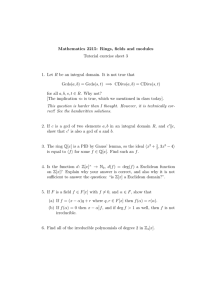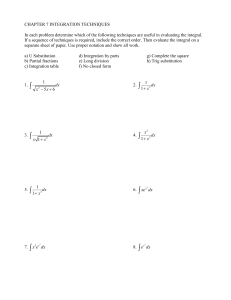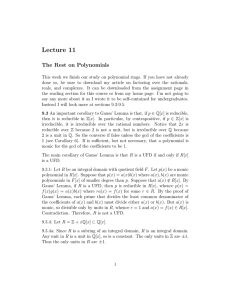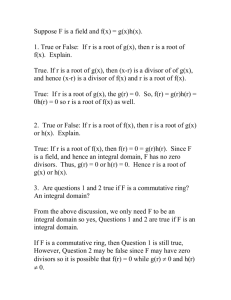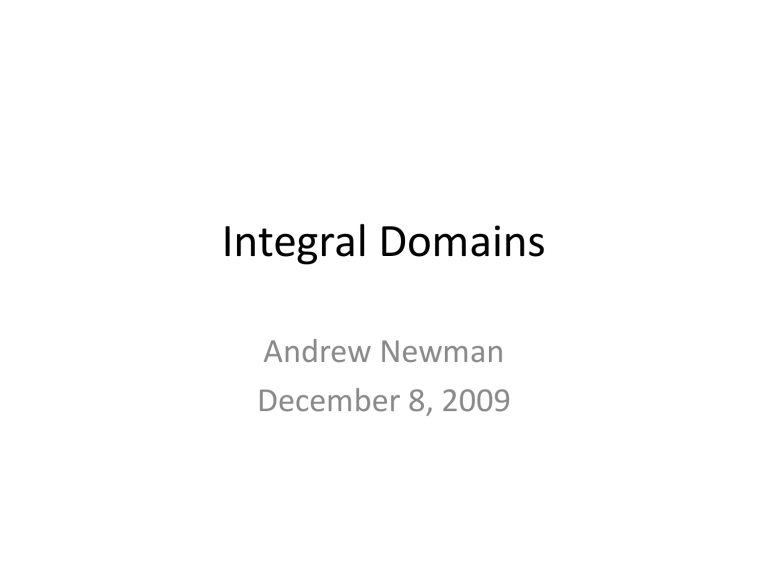
Integral Domains
Andrew Newman
December 8, 2009
16.1 – The Field of Fractions
• The field of fractions of an integral domain D,
FD is the set of equivalence classes on S =
{(a,b): a,b є D} of ~; where (a, b) ~ (c, d) if and
only if ad = bc.
• Examples
– Integral Domain: Z Field of Fractions: Q
– Integral Domain: Z5
Field of Fractions: Z5
– Integral Domain: Z[i]
Field of Fractions: Q[i]
– Integral Domain: Q[x]
Field of Fractions: Q(x)
Mathematical Results
• Lemma 16.1 – Definition of the field of
fractions, and establishes ~ as an equivalence
relation.
• Lemma 16.2 – The operations of addition and
multiplication on FD are well defined.
• Lemma 16.3 – FD is a field
Theorem 16.4
• Let D be an integral domain. Then D can be
embedded in the field of fractions FD, where
any element in FD can be expressed as the
quotient of two elements in D. Furthermore,
the field of fractions FD is unique in the sense
that if E is any field containing D, then there
exists a map ψ: FD → E giving an isomorphism
with a subfield of E such that ψ(a) = a for all a
є D.
S E
φ'
D(Z)
Ψ
Ω -isomorphism
FD(Q)
φ - homomorphism
Corollaries
• Let F be a field of characteristic zero. Then F
contains a subfield isomorphic to Q.
– Show that F contains a subring isomorphic to the
integers and therefore since the integers can be
embedded into Q, F must contain a subfield
isomorphic to Q.
• Let F be a field of characteristic p. Then F
contains a subfield isomorphic to Zp.
16.2 – Factorization in Integral
Domains
• Terms
– Unit – An element in a ring that has an inverse.
– Associates – Elements a and b are associates if
there exists a unit u such that a = ub.
– Irreducible – A nonzero element p є D that is not a
unit such that whenever p = ab, either a or b is a
unit.
– Prime – An irreducible p such that whenever p|ab,
either p|a or p|b.
Examples of Irreducibles
• Integral Domain: Z
• Integral Domain: Z5
• Integral Domain: Q[x]
Irreducibles: primes
Irreducibles: none
Irreducibles:
irreducible
polynomials
Not all irreducibles are primes
• Let R = {x2 * f(x,y) + xy * g(x,y) + y2 * h(x,y)} be
a subring of Q[x,y]. Then x2, xy, and y2 are all
irreducible however xy divides x2y2, but it
doesn’t divide either x2 or y2. So xy is a nonprime irreducible.
• Corollary 16.9 – Let D be a principal ideal
domain, if p is irreducible, then p is prime.
Types of domains
• Principal ideal domain – An integral domain every
ideal is a principal ideal
– Example: Z
– Non-example: Z[x]
• Unique factorization domain – An integral
domain such that any nonzero element that is not
a unit can be written as the unique product of
irreducible elements.
• Euclidean domain – domains on which a division
algorithm is defined.
Principal Ideal Domains
• Example: Z is a principal ideal domain because
every one of its ideals (all of which are nZ, where
n is a natural number) are generated by one
single element.
• Non-example: Z[x] is not because I = {5f(x) +
xg(x)} is an ideal but it is not a principal ideal
because 5 is in it and so is x, however the only
element that generates both is 1 and the ideal
containing 1 is the whole ring so this ideal must
generate 3 which is impossible.
Unique Factorization Domain
• Example: Q[x] is a unique factorization domain,
and in fact if F is a field then F[x] is a unique
factorization domain. (Corollary 16.12 and
Corollary 16.21) (proof)
• Non-Example: Z[i] is not a unique factorization
domain, by the counterexample 10 = 5 * 2, where
5 and 2 are irreducible and 10 = (3 + i)(3 - i) . Also
(3 – i) is an example of an irreducible that is not
prime as it divides 10 but not 5 or 2.
Theorems about PIDs and UFDs
• Lemma 16.7 Let D be an integral domain and
let a, b є D. Then
a |b
b
a .
a and b are associates
a is a unit in D
a
b
a .
D.
• Theorem 16.8 – Let D be a PID and <p> be a
nonzero ideal in D. Then <p>is a maximal
ideal if and only if p is irreducible.
Theorems about PIDs and UFDs
• Corollary 16.9 - Let D be a PID. If p is
irreducible, then p is prime.
• Lemma 16.10 - Let D be a PID. Let I1, I2, … be a
set of ideals such that I1 I2 … Then there
exists an integer N such that In = IN for all n ≥
N. This is called the ascending chain condition
(ACC).
• Theorem 16.11 - Every PID is a UFD.
Euclidean Domain
• Let ν: D → N U {0}. This is a Euclidean
valuation. A Euclidean domain has the
following properties
– If a and b are nonzero elements in D, then ν(a) ≤
ν(ab).
– Let a,b be elements in D with b ≠ 0. Then there
exists elements q and r such that a = bq + r and
either r = 0 or ν(r) < ν(b).
Examples of Euclidean Valuations
• Absolute value (creates a Euclidean domain
for the integers)
• Absolute value squared for Gaussian integers.
• The degree of a polynomial.
Theorems
• Theorem 16.13 - Every Euclidean domain is a
PID. (proof)
• Corollary 16.14 – Every Euclidean domain is a
UFD.
Factorization in D[x]
• Terminology
– Content – The content of a polynomial D[x] (where D
is a unique factorization domain) is the greatest
common divisor of a0, …, an.
– Primitive – A polynomial of D[x] is a primitive if it has
a content of one.
• Theorem 16.15 – If f(x) and g(x) are primitive
then f(x)g(x) is primitive. (proof)
• Lemma 16.16 – Let D be a UFD, and let p(x) and
q(x) be in D[x]. Then the content of p(x)q(x) is
equal to the contents of p(x) and q(x).
Theorems
• Lemma 16.17 – Let D be a UFD and F, its field of
fractions. Suppose that p(x) is in D[x] and p(x) = g(x)f(x)
where f(x) and g(x) are in F[x]. Then p(x) = f1(x)g1(x)
and f1(x) and g1(x) are in D[x]. Furthermore, deg(f(x)) =
deg(f1(x)) and deg(g(x)) = deg(g1(x)).
• Theorem 16.20 – If D is a UFD, then D[x] is a UFD.
• Corollary 16.21 – Let F be a field. Then F[x] is a UFD.
• Corollary 16.22 – Z[x] is a UFD.
• Corollary 16.23 – Let D be a UFD. Then D[x1, …, xn] is a
UFD.

